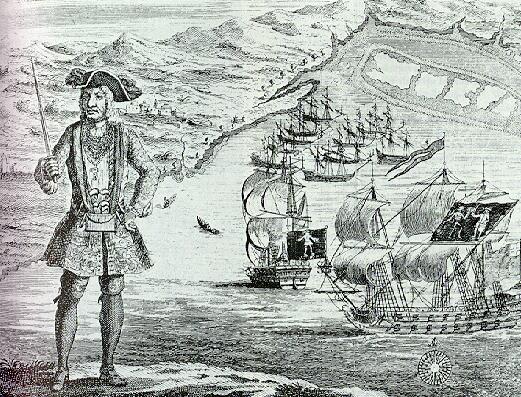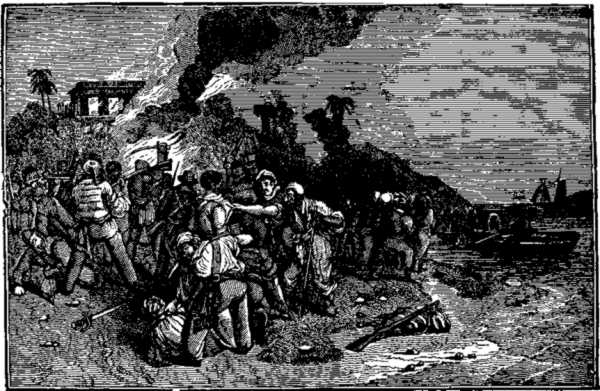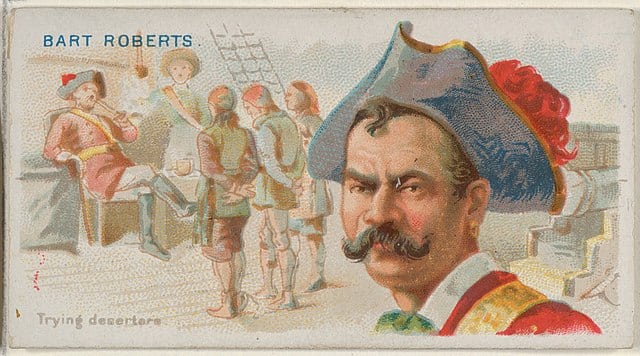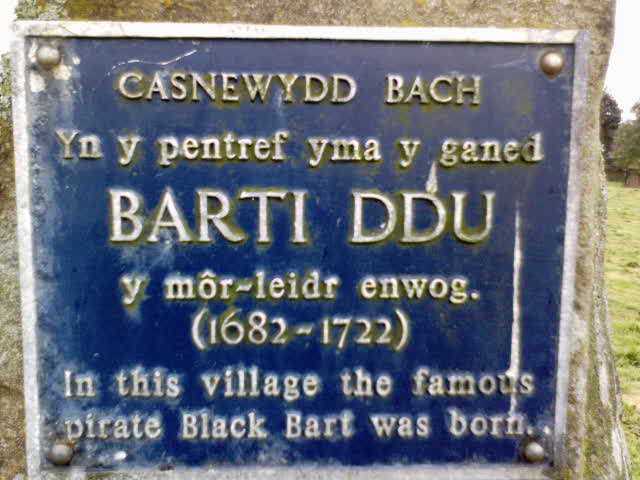We have used the term “most successful pirate” quite a few times in previous Biographics, but that’s because there is no single thing that accurately defines the success of piracy. Blackbeard was the most notorious of the bunch. Black Sam Bellamy probably accrued more wealth as a pirate than any other, while Henry Every pulled off the single biggest score in history and, more importantly, managed to get away with it.
Today, we are using another metric to establish the piratical credentials of Captain Bartholomew Roberts aka “Black Bart” – the number of prizes taken. That refers to the number of ships that he captured, plundered, or ransomed. Roberts is credited with well over 400 prizes, all within a short time frame of three years.
One of the men who defined the Golden Age of Piracy, there was a time when he was considered invincible and every merchant and sailor in the Atlantic knew and feared the name of Bartholomew Roberts.

Early Years
John Roberts was born in 1682, in the tiny village of Little Newcastle in Wales. At one point, he changed his first name to Bartholomew. We’re not sure why or when, but it was quite common for pirates to use aliases. He is also well-known today by the moniker “Black Bart,” which he shares with a Wild West outlaw whose real name was Charles Boles, maybe we’ll cover him someday, as well. However, unlike Boles, Bartholomew Roberts was seemingly never called “Black Bart” in his lifetime. Instead, this nickname came from a poem written about him hundreds of years later.
As is the case with all the other pirates we’ve covered here on Biographics, we have a dearth of knowledge when it comes to Roberts’ early years. The information we do possess about his piratical career comes to us, again, courtesy of Charles Johnson’s A General History of the Pyrates, which is not incredibly reliable, but that’s what we have to work with.
Unlike many of his compatriots, Roberts was a reluctant pirate. It is believed he became a sailor from a young age, but we have no accurate records of his service until 1719. At that point, he was already the second mate aboard a slave ship called the Princess under the command of a Captain Plumb. In the summer of that year, the Princess sailed to the Gold Coast of West Africa to pick up slaves from Annamaboe, present-day Anomabu in Ghana. On its way back, the ship was attacked by pirates under the command of Captain Howell Davis, himself a Welshman from the same county of Pembrokeshire as Roberts.

The pirates captured the Princess and plundered it of its valuable loot. When something like this occurred, there was usually one of two things that happened to the surviving sailors. If their ship was still seaworthy (and assuming that the pirates did not want to add it to their fleet), then they were usually free to go. If the ship could not sail anymore, then the remaining sailors were brought aboard the pirate vessel and either placed in a raft or dropped off at a nearby island.
In both cases, pirates usually gave some of the sailors an opportunity to join them since, after all, they needed to refill their ranks, too. This was typically done on a volunteer basis, but some men were forced to join up with the pirates whether they wanted to or not. Usually, this was because they were skilled in an important area, like medicine, carpentry, or navigation. Roberts was among the men forced to join Howell Davis’s crew aboard the Royal Rover. We’re not sure why, but maybe the captain fancied having a fellow Pembrokeshire native aboard his ship, and that is how Bartholomew Roberts became a pirate.
Becoming Captain
Roberts might not have been thrilled with being a pirate at first, but he soon discovered that he was pretty good at it and, eventually, took to it like a duck to water. Again, we don’t know much about his maritime experience prior to turning to piracy, but it seems that Roberts was a very skilled sailor and an affable person, in general, as he quickly became regarded as one of the most indispensable crewmen aboard the Royal Rover. He was so popular, in fact, that he became the new captain just six weeks after being abducted from the Princess.
His promotion came out of necessity, not any kind of enmity towards the previous captain. Davis had taken the ship to the island of Príncipe, which back then was part of the Portuguese Empire. He flew British colors and was granted safe passage into the harbor. His plan was to gain the governor’s trust, invite him aboard the Rover and then hold him for ransom.
It didn’t really work out like that. The governor didn’t fall for the ruse and, instead, planned his own counterattack. He invited the captain to join him for lunch. Howell Davis and a small retinue left his ship and traveled to the island fort, but they were ambushed along the way and executed.
With Davis dead, the Royal Rover needed a new captain. Charles Johnson describes the election process as being quite a fancy one, like you would expect to see in Parliament, and not on a pirate ship. Just like the British Parliament, the men were divided into Lords and Commons, the former being made up of officers while the latter consisted of all the regular crew members. Only the Lords were allowed to propose candidates for the position of captain, and then everyone voted on it. One Lord named Dennis proposed Bartholomew Roberts and gave an impassioned speech to show his support. He said:
“It is my Advice, that, while we are sober, we pitch upon a Man of Courage, and skill’d in Navigation, one, who by his Council and Bravery seems best able to defend this Commonwealth, and ward us from the Dangers and Tempests of an unstable Element, and the fatal Consequences of Anarchy; and such a one I take Roberts to be. A Fellow! I think, in all Respects, worthy of your Esteem and Favour.”
This was enough to garner cheers from everyone aboard the ship except for another Lord named Sympson who, presumably, had hopes of assuming the position himself and that is how Bartholomew Roberts became a pirate captain. He accepted the promotion, saying that “since he had dipp’d his Hands in muddy Water, and must be a Pyrate, it was better being a Commander than a common Man.”
Revenge, Ruse and Robbery
Once Roberts was in charge, his first course of action was to avenge the death of his predecessor. The ship started battering the Portuguese fort with cannon fire, but this was all a distraction meant to hide a 30-man expedition that had made landfall and was approaching the fort on foot. They took the soldiers inside by surprise and the survivors quickly abandoned their post and fled into town. The pirates then burned the fort down and pushed all their cannons into the sea before returning to their ship.
Some of the men did not consider this sufficient punishment as Captain Davis had been quite popular with his crew. They wanted to burn down the town itself, but Roberts considered that there was no way to do this without sustaining heavy casualties, especially now that the locals were expecting an attack. In the end, the crew of the Royal Rover compromised – they manned a French ship which they had captured in the harbor, sailed it into shallow waters near the town and shot a few cannon volleys to satisfy their need for revenge. On their way out, they even found a couple of Portuguese ships and burned them down as a bonus.
From there, the ship sailed back to Annamaboe, the place where Roberts’ piratical career first started, to pick up provisions and perform repairs. On the way, they also captured a Dutch Guineaman and an English ship called the Experiment, whose captain joined up with Black Bart’s crew. Anyway, as we said in the intro, Roberts took over 400 prizes during his three years as pirate. Obviously, we can’t mention every single one, so from here on out, we will only talk about the notable ones.

Once the ship was ready to sail, it needed a destination. The crew took a vote and selected Brazil. They embarked on a month-long trip and arrived at an uninhabited island off the coast of Brazil named Ferdinando, which served as their base of operations for the months to come.
Roberts spent around nine weeks prowling the waters of South America, but found very slim pickings when it came to prizes. He and his crew decided to sail to the West Indies instead, and were getting ready to leave when they chanced upon a remarkable sight – it was a large Portuguese fleet of 42 ships, sitting in Brazil’s All Saints Bay, waiting for two powerful men-of-war to escort them back to Lisbon.
Obviously, Roberts was heavily outnumbered, but this did not deter him. Where other pirates would have immediately turned around and set sail as fast as possible, he simply looked for an alternative strategy. He didn’t engage the fleet in open combat, of course, but Roberts reckoned that, with the element of surprise on his side, he could capture one ship and make his escape before the rest of the fleet caught on. The question was – which ship?
One advantage when dealing with a large fleet is that it is pretty easy to get lost among them. The Royal Rover was able to infiltrate the fleet without anybody noticing. They approached one of the Portuguese vessels and persuaded their ship’s master to come aboard the Rover. Only then did he understand the situation – he was on the deck of a pirate ship. If he tried to give any signal or sign of distress, he would be immediately cut down and his own ship would be attacked and plundered without giving any quarter. Instead, Captain Roberts promised him that he would be returned safe & sound and his vessel left alone and the only thing he had to do was point at the richest ship in the fleet. Unsurprisingly, the Portuguese captain found this an offer he couldn’t refuse and directed the pirates towards a large, 40-gun ship which was significantly more powerful than the Royal Rover.
Even so, it clearly was not expecting one of the other ships to open fire on it and, despite its strength, the pirates managed to claim it with only two casualties. They were sailing away by the time the rest of the fleet realized what had happened and, by then, it was already too late to catch up to them.
Once they were safe, the pirates inspected their plunder and discovered that they had struck the motherlode. The ship’s cargo was filled with valuable goods such as tobacco and sugar, jewels and precious gems including a gold cross set with diamonds made especially for the King of Portugal, and over 40,000 Portuguese gold coins called moidores.
The Pirate Code
After that successful score, the pirates sailed up north for a bit, and began prowling the waters off the coast of Suriname and Guyana. After taking a few more prizes, fortune changed for Bartholomew Roberts. He had heard of a Portuguese brigantine sailing those waters and wanted to plunder it. He assembled a group of 40 men and boarded a sloop, which was smaller than the Rover, but also faster. Meanwhile, he left his own ship, as well as the captured Portuguese vessel with all the loot, in the command of a crew member named Walter Kennedy.
The sloop had no luck going after the brigantine. Roberts spent eight days trying to catch up to the Portuguese ship, but opposing winds and currents just kept driving him back further. Eventually, the supplies were starting to run out so he had to give up the chase, but that’s when things went from bad to worse. The sloop was approached by a boat containing some of the men left behind on the Rover and they informed Roberts that, in his absence, Kennedy had proclaimed himself captain, with the support of some of the men. The ones still loyal to Roberts were allowed to depart on the captured Portuguese prize, but everybody else took the Royal Rover and sailed away. It seems that they split the loot in half before departing, so there was, at least, some honor among thieves.
In the end, this turned out to be a poor choice for the men aboard the Rover. Many of them wanted to leave the pirate life behind or, at least, take a break to spend some of their treasure. They intended to go to Ireland, but there weren’t any good navigators among them, so they ended up in Scotland. There, the rowdy pirates started causing problems in every town and village they walked into and many of them were arrested. Once the local authorities established that they were pirates, they risked a death sentence so, in order to avoid the hangman’s noose, they started giving evidence against each other, leading to even more arrests and executions. As for Walter Kennedy, he quickly spent most of his share of the treasure, then he traveled to London where he was recognized by a sailor whose ship he once attacked. He was arrested and executed for piracy in 1721.
Back to Roberts and his men, after their anger at the betrayal started fading, they resolved to devise a new way to keep the order and try to prevent something like that from happening again, so they came up with a pirate code.
Now, there are a lot of misconceptions about the pirate code so let’s quickly get some of them out of the way. Black Bart’s pirate code wasn’t the only one; it wasn’t even the first that we know of, but given Roberts’ high profile and the fact that his code was described, in detail, in Charles Johnson’s book, it became the most famous. We should also point out that there has never been a universal code that all pirates around the world were somehow obliged to obey. Walking up to a pirate and saying “parley” would not have magically stopped him from killing you.
Most of the articles in Roberts’ code had to do with discipline aboard the ship and the distribution of plunder. Some of them were pretty obvious – no gambling, no stealing, no fighting aboard the ship. Some were a bit weirder. The eleventh article, for example, said “The Musicians to have Rest on the Sabbath Day, but the other six Days and Nights, none without special Favour.”
Many of the rules show a discipline that we would normally not associate with pirates. All the crewmen were expected to keep their swords and pistols clean and fit for service. There was a curfew at 8 o’clock at night, and those who wanted to keep drinking, or talking, or whatever pirates did were only allowed to do so above deck.
No boys or women could be brought on the ship. If a woman did, somehow, end up aboard, she was to be guarded by a sentinel to “secure the lady’s virtue,” and any attempt to molest her would have been punishable by death. Pirates also risked death or marooning if they abandoned their posts during battle, but that one was to be expected.
Finally, there were a few articles that talked about how the loot was split. There is a misconception that the captain took most of the treasure, and this is not true at all, not only in Roberts’ case, but with all captains. Most men turned to piracy to make money, they would not have accepted to risk their lives just to make money for someone else. Even the hint of such a rule would have resulted in instant mutiny. No, Roberts (and, presumably, most other pirate captains) was entitled to a double share, meaning that he only took twice as much as any crewman. The quartermaster also had a double share; the master, gunner, and boatswain took a share-and-a-half, while all the remaining officers were entitled to a share-and-a-quarter.
The provisions and the liquor were divided equally among the whole crew, and each man was free to enjoy his portion at his discretion, unless there was a scarcity, at which point a “vote of retrenchment” would be called for. The pirates were even entitled to worker’s compensation. If they lost a limb during service, they would have received $800 from a public fund, and proportionately less money for smaller injuries.
This all sounds nice in theory, but it shouldn’t give you the wrong impression about life aboard a pirate ship. In reality, pirates were more often than not willing to steal, cheat, fight, rape, and murder to suit their own desires and trying to keep them all in line was a constant challenge for the captain and his officers.
Death in Battle
Deprived of the Royal Rover, Roberts had to use his sloop as his new flagship. He renamed it the Fortune, a name he would use for other ships, as well, going forward. Of course, it wasn’t as powerful as his former craft, so he had to choose his fights more carefully. He was successful multiple times, but in early 1720, he was chased out of the West Indies by a few well-armed French pirate hunters, who had been assembled specifically to deal with Black Bart and his ilk.
Roberts sailed north all the way up to Newfoundland, in present-day Canada, where he arguably caused most of his destruction. In late June, he entered the harbor of Trepassey, which was filled with 22 merchant and shipping vessels. None of them were equipped to fight pirates, so they were all at the mercy of Bartholomew Roberts, and they found it lacking. The pirate burned down all the ships, except for one galley which was added to his fleet. Not long afterwards, Roberts encountered a French convoy of ten ships which, again, he destroyed, except for another sloop which he kept and exchanged it for the galley.

The prizes kept on coming, one after another, with little to no reprisals from the targets as none of them were powerful enough to match up against the pirate fleet. Eventually, Roberts decided it was time for another change of scenery, so he sailed back to the West Indies, where he continued his plundering ways mostly unimpeded. Worst thing that happened to him was that another one of his officers, a man named Thomas Anstis, deserted and took one of the ships with a full crew and went independent. This happened while Roberts was headed to Africa because, again, he thought it was time to change locations. Anstis and his men wanted to keep sailing the Caribbean, so they snuck away during the night.
In Africa, it was business as usual for Roberts and his crew as they kept plundering dozens of vessels. Roberts might have liked to dress up in fancy clothes and speak like a gentleman, but he showed his true barbaric side when the captain of a slave ship refused to pay a ransom, so Black Bart had his vessel set on fire, with all the slaves still trapped in the galley.
This happened in January, 1722, and perhaps in a display of karma, the end came for Roberts just a few weeks later, on February 10, when he encountered the HMS Swallow of the Royal Navy, captained by Chaloner Ogle. This was a 50-gun ship-of-the-line and would have been more than a match for Roberts even on a good day and this was not a good day for the pirate captain. Earlier that morning, Roberts had taken a prize – a trading vessel called the Neptune. Consequently, most of his men had been drinking and partying all day and were completely unfit for duty.
The Swallow had already destroyed one of the other ships in the pirate fleet on its way to engaging Roberts aboard the Royal Fortune. Black Bart had no intention to fight. He wanted to run away, but since he was partly surrounded by coastline, he had to turn around and sail within range of the Swallow’s cannons. His ship would be exposed to, at least, one broadside shot.
Chances of sustaining heavy casualties from one shot were small, but fortune was not with Bartholomew Roberts that day. The first grapeshot from the Royal Navy ship hit him right in the throat, killing him instantly. His men obeyed his final wishes and quickly buried him at sea, but their will to fight had disappeared and surrendered soon after.
Bartholomew Roberts, the dread pirate thought by many to be indestructible, feared throughout the whole of the Atlantic after plundering hundreds of ships, was finally dead. He was the last of the well-known pirates. All the other ones – Blackbeard, Henry Every, Calico Jack, Black Sam Bellamy, Charles Vane – they all died before him, so many consider that the end of Bartholomew Roberts also signaled the end of the Golden Age of Piracy.
